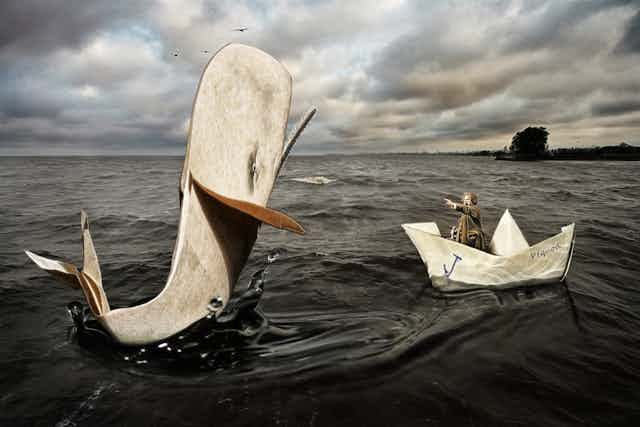Pick up Herman Melville’s Moby-Dick (1851) expecting the story of a mad one-legged captain chasing a white whale and you’ll get more than you bargained for. This is a novel that announces itself as the tale of a whaling voyage, and expands from there as if to encompass the whole of existence. Its narrator, Ishmael, admits he is overwhelmed:
Friends, hold my arms! For in the mere act of penning my thoughts of this Leviathan, they weary me, and make me faint with their out-reaching comprehensiveness of sweep, as if to include the whole circle of the sciences, and all the generations of whales, and men, and mastodons, past, present, and to come, with all the revolving panoramas of empire on earth, and throughout the whole universe, not excluding its suburbs.
For Ishmael, everything is connected and “there is no staying in any one place; for at one and the same time everything has to be done everywhere”.
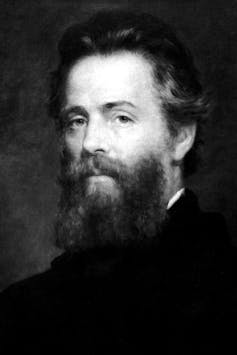
The forward progress of “what there may be of a narrative in this book” is constantly hampered by Ishmael’s need to consider his subject from all angles, addressing the viewpoints of different characters as well as the perspectives of different cultures and branches of learning, together with historical and mythic parallels, technical details, workplace practices and the philosophical questions these give rise to.
Even in the midst of the final chase that drives the novel to a close with extraordinary momentum, Ishmael cannot resist inserting a footnote to clarify his use of the term “pitchpoling”.
The result is a radically discontinuous, multi-stranded text which insists on its own incompleteness as “but a draft of a draft”. In The Modern Epic (1996), the great literary scholar Franco Moretti contends that novels such as Herman Melville’s Moby-Dick and James Joyce’s Ulysses have become like:
sacred texts that the modern West has subjected to a lengthy scrutiny, searching in them for its own secret.
But whereas the ancient epic presents the world as a unified and coherent totality, the modern world can only hope to express itself through fragmentation, dialogue, digression and collage.
Moby-Dick’s explosion of narrative conventions was so revolutionary in its time that it perplexed Melville’s contemporaries and passed quickly into obscurity.
“There are evidently two if not three books in Moby Dick, rolled into one”, Melville’s mentor Evert Duykinck marveled. Readers wanted more of the relatively straightforward sea-faring adventure that Melville had delivered in his early novels Typee (1846) and Omoo (1847).
And at first, Moby-Dick seems to offer just that.
Although the famous invitation that opens the novel – “Call me Ishmael” – suggests an assumed or even an arbitrary identity, Ishmael initially presents as a more-or-less conventional first-person protagonist, telling how he packed his bag and “started for Cape Horn and the Pacific”.
But through the unlikely bond he forms with a Pacific Islander, Queequeg, Ishmael is liberated from the bounds of his individual perspective, and his cultural and racial biases.
He escapes the prison of interiority, “melting” into Queequeg through a same-sex, mixed-race “marriage” that sets the precedent for the more radical dissolution of Ishmael’s persona that takes place when he joins the Pequod’s crew.
For once the whaling cruise is underway, Ishmael tends to recede from his own narrative, declining to detail his own part in events while impossibly gaining access to a range of viewpoints far exceeding his own, including the private soliloquies of Captain Ahab.
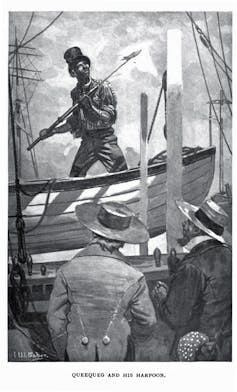
Ishmael turns out to be less a character than a conduit for other voices and perspectives. This is either a daring experiment in omniscient first-person narration, or a sign that Ishmael is utterly unreliable.
Other voices take over whole chapters, especially that of Ahab as he thumps the ship’s boards like a Lear or Richard III on the Elizabethan stage. As “one in a whole nation’s census […] formed for noble tragedies”, Ahab exerts a strong pull on the narrative, but Ishmael is eager to celebrate the “democratic dignity” of the Pequod’s multiethnic crew of “mongrel renegades and castaways and cannibals”.
The dramatic dialogue form of “Midnight—Forecastle” (Chapter 40) gives space to the voices of different crewmen, singly and in chorus, framed only by minimal “stage directions”. Generally, Ishmael declines to distinguish himself from the collective; he is merely “one of that crew” whose “shouts [go] up with the rest”.

He is also democratic in his levelling of all cultures, crediting the Hindu tradition of Vishnu’s “ten earthly incarnations”, consulting the views of “the highly enlightened Turks” alongside those of Western authorities, and beginning his history of Nantucket not with European but with American-Indian sources.
But there are limits to the novel’s inclusiveness, not least in that women are almost wholly absent. Two very minor female characters briefly appear: a chowder-making landlady and Charity, the prudish sister of one of the ship’s owners.
On the other hand, the novel makes numerous appeals to the maternal forces in nature. It also breaks down gender norms and boundaries, from Ishmael’s surrender to Queequeg’s “bridegroom clasp” to Ahab boasting of his “queenly personality” to the ambiguous mingling of “milk and sperm” in the infamously erotic chapter A Squeeze of the Hand.
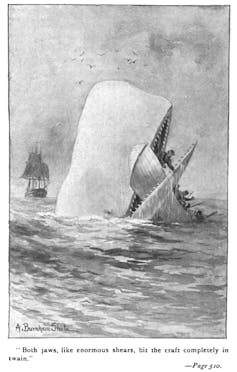
Though he recedes as a character, Ishmael’s voice remains distinct in meditative passages and in his extended inquiries into the lore and science of whales and whaling. In a series of parodically “encyclopaedic” chapters that coincide with the cutting up of a whale by the ship’s crew, Ishmael presents a breakdown of the whale’s body so comprehensive that it not only separates the “skin of the creature” but even “the skin of the skin”.
This provides material for inquiries into disciplines as diverse as astronomy, lexicography, economics and jurisprudence. This may sound dry, but so infectious is Ishmael’s intellectual energy that chapters featuring such inauspicious titles as The Blanket, Cisterns and Buckets and Of the Less Erroneous Pictures of Whales and the True Pictures of Whaling Scenes can be some of the novel’s most engrossing.
At the same time, Ishmael undermines scientific authority by privileging forms of knowledge gained through immediate, hands-on experience:
Ere entering upon the subject of Fossil Whales, I present my credentials as a geologist, by stating that in my miscellaneous time I have been a stone-mason, and also a great digger of ditches, canals, and wells, wine-vaults, cellars, and cisterns of all sorts …
Unsatisfied with simply giving the comparative dimensions of Sperm and Right Whale’s heads, he asks us to actually enter their spaces; to see and touch their surfaces. Incidentally, Melville’s life experience had been as “miscellaneous” as Ishmael’s; aspects of his extraordinary biography are reimagined in Ron Howard’s film In the Heart of the Sea (2015).
Declaring that “there is an aesthetics in all things”, Ishmael demands that his reader take interest in such matters as work-tools and their usage, devoting whole chapters to these matters. With genial bravado, he continually advances the heroic claims of his apparently mundane industrial subject (the “whale fishery”) and appropriates a lofty epic language—as when he proposes to “sing” the “romantic proceeding of decanting off [the] oil into the casks.”
A global narrative
None of this is to say that the novel is lacking in narrative incident. There are feats of superhuman prowess; there is an encounter with a giant squid; there is a typhoon producing pyrotechnic terrors.
Fast-paced action abounds as other whales are chased and caught or lost at great peril (one of the crew, the Native American harpooneer Tashtego, nearly drowns inside a sperm whale’s head).
There is the tension between Ahab and the first mate Starbuck, who comes close to killing his captain, and the spectacle of Ahab dazzling the crew with his demagoguery.
There are encounters with other ships, including a stirring contest with a German vessel, and the tale-within-a-tale of a mutiny aboard another American whaler, the Town-Ho. And let us not forget, there is voyage round the globe.
A native New Yorker, Melville commences his story in the “isle of the Manhattoes” then takes readers in a “devious zig-zag world circle” across the Atlantic and Indian Oceans via Sumatra and the Sunda Strait, the Java and Chinese Seas, through Japanese waters to a fatal conclusion somewhere along the equator in the South Pacific.
Australia rates a mention, as “that great America on the other side of the sphere”, and Sydney as the source of the world’s most treacherous sailors (Melville himself had shipped on the Sydney whaler The Lucy-Ann in 1842). The voyage also yields political allegory, as numerous hints frame the Pequod as a symbolic “ship of state”, with running analogies between the whaling voyage and the United States’ imperial expansion, and various allusions to class conflict and slavery (especially when Ahab briefly forms a bond with the black ship’s boy Pip).
The novel conveys the wild energy of whaling life. A whaleman is “rocked to sleep between billows […] while under his very pillow rush herds of walruses and whales”. He spends so long at sea that the land starts to smell “strange[r] than the moon would to an Earthman”.
Physical and meta-physical
Melville excels in physical description, and he knows the bodily pleasures of such words as “plunge” and “suck”. He can raise us to giddying heights as Ishmael and Ahab revolve the mysteries of existence, then plunge us back to earth with bawdy humour, as in Chapter 95 when one of the crew wears the skin of a whale’s mighty penis (AKA “the Grandissimus”) as protective clothing.
Extraordinary metaphors and similes collapse the distance between disparate realms, as when Ishmael peeps into a Sperm whale’s head to find:
a really beautiful and chaste-looking mouth! from floor to ceiling, lined, or rather papered with a glistening white membrane, glossy as bridal satins.
Like the metaphysical poets, Ishmael fuses the abstract and the mechanical: “Top-heavy was the ship as a dinnerless student with all Aristotle in his head”, we read in Chapter 110.
Vivid violence
Be prepared for violence against nature. To the extent that Melville draws on his own whaling experience, animals were harmed in the making of this book. But though Ishmael is hardly out to “save the whales”, he can be sensitive to animal rights, contending that “the first man that ever murdered an ox” deserved to be “put on his trial by oxen” and that a cannibal is no worse than the “civilized” gourmand who tortures geese to get his pâté de foie gras.
He enters into non-human perspectives, imagining “how appalling to the wounded whale” the boats that surround it must appear, though the victim has “no voice” in its “agony of fright”.
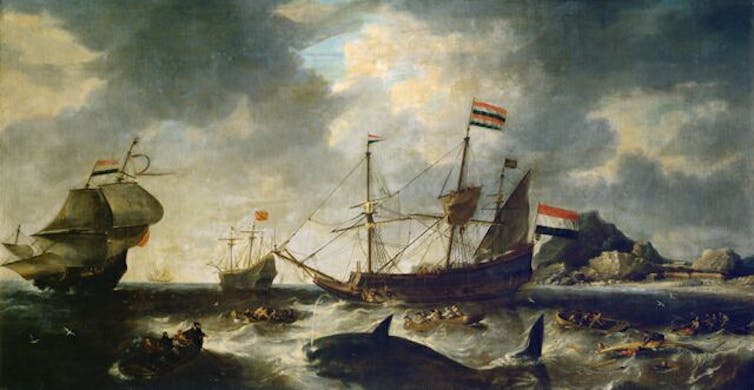
The whales in this novel are silent: Melville did not know about whale-song, and in any case sperm whales do not sing, though the music of the prose conveys a sense of their awesome vitality.
The impotence of humankind against the ocean’s physical force and destructive capacity is also a constant theme, and Ishmael introduces “archaeological, fossiliferous, and antideluvian points of view” that challenge anthropocentricism itself (fittingly, a recently discovered fossil whale was named albicetus – meaning “white whale” – in honour of Moby-Dick).
He even reflects on climate change, gaining “dim, shuddering glimpses into those Polar eternities; when wedged bastions of ice pressed hard upon what are now the Tropics” when contemplating a whale’s bones.
All about Ahab
While Ishmael’s digressive habits threaten to derail the narrative, Ahab’s “fixed and fearless, forward dedication” always steers things back on track. Ahab’s desire for vengeance stems from a previous encounter with the white whale in which he lost his leg.
He piled upon the whale’s white hump the sum of all the general rage and hate felt by his whole race from Adam down; and then, as if his chest had been a mortar, he burst his hot heart’s shell upon it.
Ahab himself admits the insanity of the hunt:
All my means are sane, my motive and my object mad.
With no regard for the lives of his crew, Ahab is at once an archaic “sea-king” bent on “supernatural revenge” and a modern industry boss whose soul runs on “iron rails” and who views his men as mere “wheels” to his “cogged purpose”.
When obstacles arise, he is a master of insults and curses, coining such gems as “The black vomit wrench thee!” But his greatest vitriol is reserved for the white whale itself:
to the last I grapple with thee; from hell’s heart I stab at thee; for hate’s sake I spit my last breath at thee.
Insight into Ishmael
What about Ishmael? For him, the horror of the whale lies principally in its whiteness. In “The Whiteness of the Whale” (Chapter 42), Ishmael offers a sublime disquisition on whiteness as “the intensifying agent in things the most appalling to mankind”, a terrifying blank that “shadows forth the heartless voids and immensities of the universe”.

Ahab shares Ishmael’s nihilistic dread: his desire to spear the white whale is partly a desire (as he says) to “strike through the mask!” of outward appearances, though there may be “naught beyond”. Literary critics have found various other meanings in the white whale, seeing it variously as an image of divinity, white supremacy, indifferent nature, a “toothed womb”, a Lacanian phallus. Ultimately, the whale is a cipher that can bear all these interpretations, and does not require us to choose between them.
Moby-Dick is a tragic, comic, eccentric and electrifying attempt to come to terms with the riddle of existence; to heal the Cartesian splitting of mind from body; to engage with the whole history of ideas and socio-political forms.
The jolting juxtaposition of disparate elements makes for a wilder ride than any linear narrative could offer—hence the annual marathon readings at the New Bedford Whaling Museum, where enthusiasts from around the globe gather to read this great world-text aloud (it takes about thirty hours).
Figures as diverse as William Faulkner and Barack Obama have named it their favourite book. Moby-Dick is not Melville’s only well-known work (his novella Bartleby the Scrivener (1853) has been described as “the original Occupy Wall Street”) but it is certainly his most celebrated, rising up like an iceberg – or the great white whale itself – from the waters of 19th-century fiction.
More than 150 years after its publication, readers continue to search for its secret.
Pitch an article idea for the Guide to the Classics series to the Arts + Culture editor.

